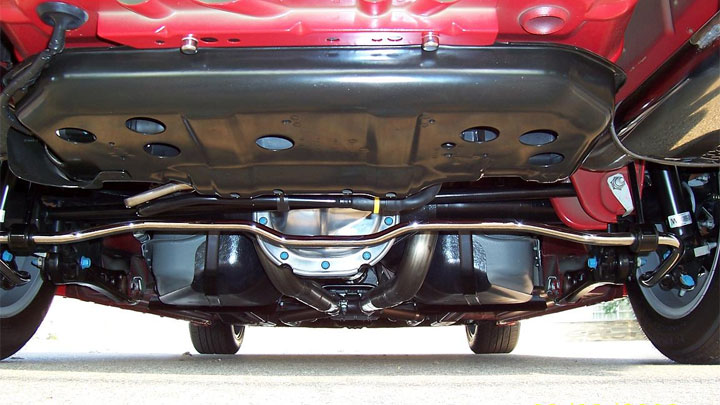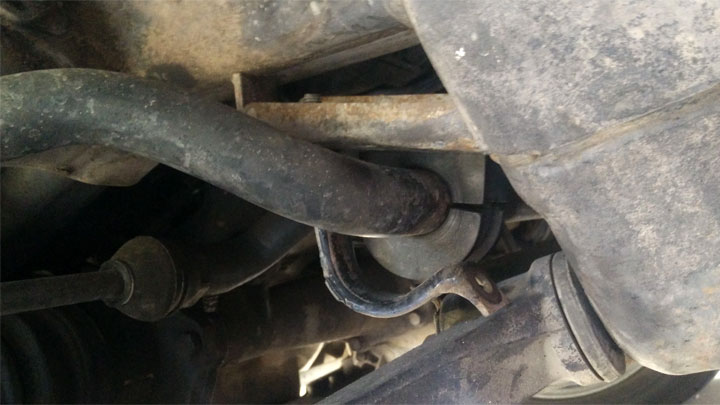3 Symptoms of a Bad Sway Bar or Link (and Replacement Cost)
In this article we will explain the function of the sway bar (or bars) on your vehicle and some of the most common signs of failure. Other terms you may have heard for this part include stabilizer bar, anti-sway bar or anti-roll bar.
We’ll also look at why sway bars and links go bad and how much it’s going to cost to replace them. But first, let’s quickly go over the differences between these two parts.
What Is a Sway Bar?

A sway bar is a solid or hollow steel bar attached with clamps and non-metallic bushings to the frame of your car.
The bar ends are each symmetrically bent at an approximate right angle to the bar centerline and are attached to the vehicle’s suspension elements (for example, to the lower A-frames or to the shock struts) with short links. More on these links in a moment.
As the suspension moves up and down the links will twist the bar in proportion to the suspension movements.

What Are Sway Bar Links?
As mentioned above, the links attach the ends of the bar to the suspension. These links generally include self-aligning end fittings that allow each link to align itself with the bar end and with the suspension element it is attached to.
In some designs, the link ends attach to the bar with self-aligning rubber bushing-type fittings.
See Also: 6 Signs of a Bad Tie Rod End
Bad Sway Bar Link Symptoms
The highest wearing parts on any sway bar installation will be the links. Here are three key symptoms that you will note when the links finally become worn out.
#1 – Noise When Turning

A low level clunking noise or rattle will be noticed when driving especially when going through a corner. The self-aligning fittings at the ends of each link have become loose.
Related: 9 Causes of Noise When Turning
#2 – Noise When Going Over Bumps
If symptom 1 above is not addressed a sway bar link can detach from the suspension or from the bar end. When this happens a loud clattering noise will be noticed when the car goes over a bump.
#3 – Vehicle Handling Worsens

There can be some degradation in the handling of your car when a sway bar link fails. The amount of lean when driving through a corner may noticeably increase because the bar is no longer doing its job.
Unless you’re the type that spends their weekend at their local track, on the Tail of the Dragon, or even the Nürburgring, you may not be sufficiently sensitive to notice this difference in handling. The noises described above will be the most obvious failure warning signs.
These symptoms must be addressed as soon as possible. The car can be driven for a few days with a failed sway bar link. You should slow down a bit more while cornering. And you should get the necessary repair work completed without delay.
What Is the Purpose of a Sway Bar?

I am confident that while driving, you have experienced how your car rolls (leans) to the outside of any corner. Turn left, the car leans to the right; turn right, it leans to the left.
The faster you are driving, the more the car will lean in a corner. This behavior, even if not too extreme, can typically be uncomfortable.
It also can adversely affect the car’s handling because the lean and the accompanying motion of the suspension will change each tire’s alignment with the road surface. A tire that leans left or right will experience degraded grip to the pavement. You simply cannot go around any corner very fast in your car if it leans a lot in the turn.
These adverse handling effects can in part be mitigated by a properly designed sway bar. And the majority of cars built today will incorporate at least one and most likely two of these clever devices. One will be located at the front and one at the back.
The bars and how they mate to the car and to the suspension elements will have the following effect:
- In a turn, as the car leans, each sway bar will apply a force downward on the suspension that’s on the outside of the turn. And an equal upward force will be applied to the suspension that’s on the inside of the turn. This combination of forces can be considerable and will assist in maintaining the car at a more level attitude when cornering.
Properly designed sway bars can almost completely eliminate the leaning or rolling effect when a car turns. This is a very remarkable benefit. And the sway bars do this while making the suspension just a little bit stiffer than would be the case if no sway bars were present.

Sway bars add to your car’s handling characteristics a quality called “roll resistance”. And this quality can be adjusted by the bar stiffness at each end of a car.
Automobile designers intentionally calibrate a car’s roll resistance, front to rear, to help improve its handling qualities. All of this is invisible to the car owner, but a car’s responsive handling and flat behavior in turns is generally pleasurable and confidence-inspiring for most drivers.
The Other Sway Bar Problem
The sway bar is attached to the car’s frame or underbody structure with two clamps each lined with a non-metallic material like hard rubber or urethane. This material can wear out and the bar will then become loose.
It will produce a rattling noise at different times while driving, but especially over a rough road surface. Also a loose bar can slide to the left or right and allow the links to misalign with the suspension attachment points. This can add to the audible clatter.
What Causes Sway Bar Links To Go Bad?

As with most everything else in life, sway bar links simply wear out due to age.
The links generally have a rubber boot to preclude water and dirt entry to the link internal parts. This boot usually fails first, and then road grit and water gets into the link joint and wears it out.
How Long Do Sway Bar Links Last?
The links provided by the manufacturer on your new car will last a long time. Useful life of 150,000 miles is not unusual. Replacement parts, if not OEM (made by your car’s manufacturer), will usually not last nearly this long. And links that are made overseas tend to be even more prone to a shorter life.
If you are having the repair done by a private repair shop, you would be wise to specify that the replacement links they install be made by an American manufacturer. They will cost a few bucks more than the imported parts but will last far longer.
Sway Bar Replacement Cost
Best places to order parts? See: 19 Best Online Auto Parts Stores

It is rare that an entire sway bar and related parts need to be replaced.
But if this should be the case, the costs could run up to $500 for parts and about $150 for labor for either the front or rear bar. With any foreign-made high performance car this cost will most likely be higher.
Sway Bar Link Replacement Cost

Replacing just the links will be far less costly than replacing the entire sway bar assembly. Each sway bar has two links. When one fails, both should be replaced.
Making this repair with high quality American-made links will cost about $80 to $100 for parts and $100 for labor. The parts cost may be higher if OEM parts are used. And if your vehicle is an expensive foreign model, expect higher costs for this job.
Sway Bar Bushing Replacement Cost

Bushing replacement costs will range from about $40 for parts plus about $75 for labor. This would cover replacement of the two bushings on either the front or rear bar.
Read Also: Control Arm Bushing Replacement Cost
Can a DIYer Do This Job?
Yes, a good home mechanic can perform both a link replacement job and the replacement of the bushings. Having a shop manual for your car will be of benefit for such a project.
The biggest challenge you may face will be removing the old parts, especially for a car that has lived its life in a northern climate.
In those areas, an abundance of salt gets applied to winter roads. The resulting corrosion damage can make many chassis and suspension fasteners very difficult to remove. Do take a look under your car at the bar and its associated parts. Assess the condition of the nuts and bolts before you decide to do this job yourself.
- DIY Car Repair Tools – Floor Jack and Jack Stands - Dec 12, 2023
- DIY Car Repair Tools – Socket (Ratchet) Wrench - Nov 9, 2023
- DIY Car Repair Tools – Torque Wrench - Apr 20, 2023

My 2011 Nissan Pathfinder, 324,000 miles, is squeaking in the rear when making turns and when stopping. However, it doesn’t squeak when pushing up and down on the bumper. The rear sway bar, bushings and links are all original and don’t appear loose. Could the bushing or links be going bad?
It could be the bushings, yes. One thing you could try is to spray a little white lithium grease or silicone lubricant between the sway bar and the bushing. Sometimes these bushings get dirt trapped between them and the sway bar and all that’s needed is a little lubricant to keep the noise away. While you’re down there, I would inspect the suspension to make sure there’s nothing more serious going on.
I just had mine replaced on my Yukon by a friend and two weeks later one is missing and the other is missing the bigger bushing I think and flipped up side down . I only noticed it when I was going to change out my number 8nsoark plug . Which I could finally get to be susr I loaned my car out and they had a front blow out and the whole wheelwell came out undamaged like nothing had happened to it. They changed the whole tire and rim and now all my light for the tire stablelight check engine light are all going off. Should I be concerned that someone is tampering with my vehicle or do these things happen just like I explained ? I’m not thinking so.
I have no idea. I suppose it’s possible, but perhaps the bolts just came loose and backed out. Vibration can cause bolts to loosen if they are not tightened to spec.